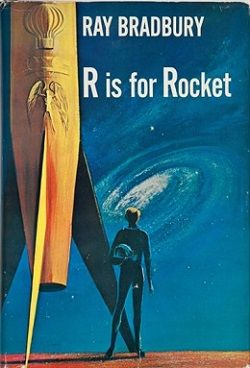Summary

R Is for Rocket
by Ray Bradbury
He can make you see things that have never been seen by human eyes.... feel things that no flesh-and-blood creature has ever felt. He can create visions so compelling that they literally seem to dance before your eyes. He can push you back to the beginnings of time and then suddenly, without warning, thrust you forward t the outmost limits of the future. He can make you so much a part of his strange worlds that you literally scream to get out.
.
Read
R Is for Rocket on http://kissnovel.net
Martial Peak Reviews
Ray Bradbury's R Is for Rocket is a masterful collection of short stories that showcases the author's unparalleled ability to transport readers into realms of imagination and wonder. Published in 1962, this anthology encapsulates Bradbury's signature style, blending elements of science fiction, fantasy, and poignant human emotion. The blurb aptly captures the essence of Bradbury's storytelling prowess, hinting at the profound experiences that await within the pages of this book.
At its core, R Is for Rocket explores themes of exploration, nostalgia, and the human condition. Bradbury's fascination with space travel and the unknown is evident throughout the collection, as he delves into the dreams and aspirations of humanity. The stories invite readers to ponder the possibilities of the universe while simultaneously reflecting on the intricacies of life on Earth. This duality creates a rich tapestry of narrative that resonates deeply with readers, making them question their own existence and place in the cosmos.
One of the standout stories in the collection is "The Rocket," which tells the tale of a father who wishes to take his children on a journey to space, despite the financial constraints that bind him. This narrative not only highlights the theme of aspiration but also delves into the emotional landscape of familial love and sacrifice. Bradbury's character development shines here; the father is portrayed as a dreamer, a man caught between the harsh realities of life and the boundless possibilities of his imagination. The children, too, are vividly drawn, embodying the innocence and wonder that often accompany childhood dreams. The poignant conclusion of the story leaves readers with a bittersweet sense of longing, a hallmark of Bradbury's storytelling.
Another notable story, "The Settlers," presents a thought-provoking exploration of colonization and the human desire for exploration. Set on Mars, it examines the complexities of human interaction with new worlds and the consequences of our actions. Bradbury's ability to create vivid, immersive settings is unparalleled; he paints Mars not just as a backdrop but as a character in its own right, filled with its own history and mysteries. The settlers' struggles and triumphs serve as a microcosm for humanity's broader quest for belonging and understanding in an ever-expanding universe.
Throughout the collection, Bradbury's prose is lyrical and evocative, often bordering on poetic. His use of language is deliberate and impactful, with each word carefully chosen to evoke emotion and imagery. The stories are rich with sensory details, allowing readers to feel the warmth of the sun on their skin or the chill of the Martian winds. This immersive quality is what sets Bradbury apart from many of his contemporaries, as he invites readers not just to observe but to experience the worlds he creates.
In terms of character development, Bradbury excels at crafting relatable and multidimensional characters. Each protagonist grapples with their own fears, dreams, and desires, making them resonate with readers on a personal level. For instance, in "The Illustrated Man," the titular character is a canvas of tattoos that tell stories of the future, each inked image revealing a different facet of humanity's potential. This story serves as a powerful metaphor for the choices we make and the paths we take, emphasizing the interconnectedness of our experiences.
Moreover, Bradbury's exploration of technology and its impact on society is a recurring theme throughout the collection. In stories like "The Veldt," he warns of the dangers of over-reliance on technology and the potential for it to alienate us from our loved ones. This cautionary tale resonates even more in today's digital age, where the lines between reality and virtual existence continue to blur. Bradbury's foresight in addressing these issues adds a layer of depth to his work, making it relevant across generations.
The overall impact of R Is for Rocket is profound. Bradbury's ability to blend the fantastical with the deeply human creates a reading experience that is both entertaining and thought-provoking. The collection serves as a reminder of the power of imagination and the importance of dreaming, even in the face of adversity. Each story leaves an indelible mark on the reader, prompting reflection on their own aspirations and the nature of existence.
In comparison to other authors in the science fiction genre, Bradbury's work stands out for its emotional depth and lyrical quality. While contemporaries like Isaac Asimov and Arthur C. Clarke often focused on the technical aspects of science fiction, Bradbury's narratives are imbued with a sense of wonder and humanity. His stories transcend the genre, appealing to readers who may not typically gravitate towards science fiction. This universality is a testament to Bradbury's skill as a storyteller.
In conclusion, R Is for Rocket is a timeless collection that showcases Ray Bradbury's extraordinary talent for weaving together the threads of imagination, emotion, and human experience. It invites readers to embark on a journey through the cosmos while simultaneously reflecting on the intricacies of life. Whether you are a long-time fan of Bradbury or a newcomer to his work, this collection is sure to leave you enchanted and contemplative, urging you to dream beyond the stars.
























Reviews 0
Post a Reviews: